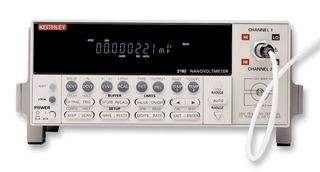

Low levels of DC drift and noise are among the best-known attributes of DC nanovoltmeters. In a typical nanovoltmeter, acceptable noise levels can be achieved by using extended integration periods of 30 seconds or more and by filtering the response. When used in this way, Keithley’s new Model 2182 Nanovoltmeter has lower noise than either earlier types of nanovoltmeters or sensitive DMMs.
However, the Model 2182’s design has been optimized to make low noise measurements in just a few seconds and to measure low-resistance materials or devices by using the reversed-current method. The result is a nanovoltmeter that provides significantly lower noise performance for real-world measurements made at higher speeds, in other words, rates faster than the thermal time constant of the sample.
This makes the Model 2182 a much better choice than DMMs or earlier nanovoltmeters for research, metrology, and sophisticated low voltage testing applications. It also offers the greatest measurement value of any nanovoltmeter available. Not only is it priced lower than earlier models, but it reduces the need for a computer controller when making sensitive precision I-V measurements by providing the ability to coordinate control of an external source.
The Model 2182 can often simplify experiments by coordinating the operation of a current source with the nanovoltmeter and by making low noise measurements in a short time.
This approach ensures the true value is readily displayed, with the offsets already canceled out by the current reversal. The Model 2182 can make low voltage, low noise measurements quickly, so these reversals can be easily done at periods ranging from 0.12 to eight seconds, easily compensating for changing thermal offsets with longer time constants. Noise is further reduced by averaging the compensated readings internally. The nanovoltmeter and current source complete the measurement process without the need for an external computer controller. The Delta Mode can be programmed using either the front panel controls or via the IEEE-488 bus.
The Model 2182’s Delta Mode performs low voltage measurements easily and precisely using the current reversal method. When used with a triggerable external current source, such as an instrument in Keithley’s Series 2400 Digital SourceMeter line, this Delta Mode automatically triggers the current source to alternate polarity, then triggers a reading at each polarity, for example, at t1 for the positive current and at t2 for the negative current.
For simple low voltage measurements, choose the speed/filter combination that best fits the experiment’s response time and noise level requirements. The Model 2182’s wide variety of selectable response times simplifies optimizing these speed/noise tradeoffs. Noise levels are assured over a wide range of useful response times: <25nV p-p at 1s or <70nV at 60ms when integrating over a 60Hz line cycle and <6nV if a 25s response time can be used.
The Model 2182 combines the accuracy of a DMM with low noise at high speed for highprecision metrology applications. Its low noise, high signal observation time, fast measurement rates, and 2ppm accuracy provide the most cost-effective meter available for applications such as intercomparison of voltage standards and direct measurement of resistance standards.
Low-level measurement instruments are often accompanied by impressive specifications, but when connected to the experiment, major issues that weren’t covered in the specifications may arise. For example, the level of transient current the instrument introduces to the sample is one of these issues Keithley has addressed in the design of the Model 2182.
Transient currents generated in the input are lower than those in our previous nanovoltmeter, the Model 182 Sensitive Digital Voltmeter, which has lower transients than most sensitive DMMs or a Nanovolt/Micro-ohm Meter. That ensures the Model 2182 can be used effectively with Josephson Junction arrays and other sensitive devices with less disturbance than previous instruments.
Interference from power lines can be critical at nanovolt levels, so the Model 2182 has the ability to synchronize its measurement cycle to the line, minimizing variations due to readings that begin at different phases of the line cycle.
Keithley has been an industry leader in the design and production of high accuracy nanovoltmeters for more than thirty years. The Model 2182 builds upon this expertise and incorporates the latest advances in the measurement of low-level phenomena.
Model No
2182
Condition
Used
Manufacturer
Keithley
Hey👋Let's start with your email